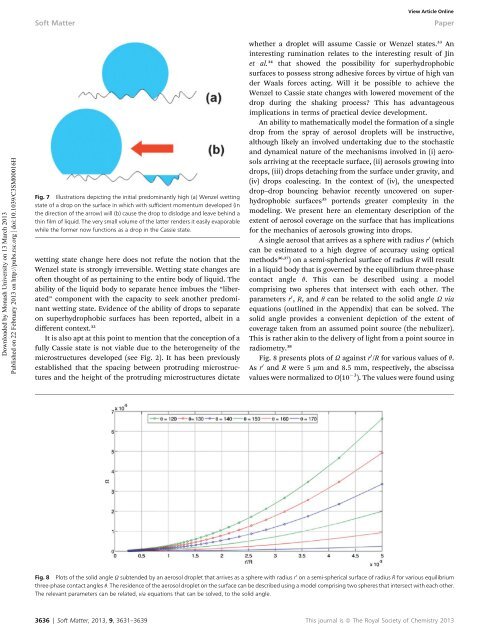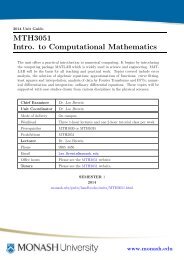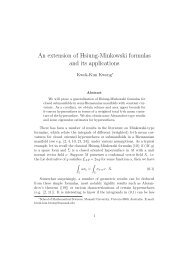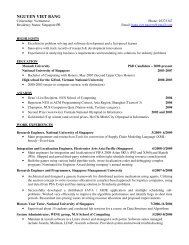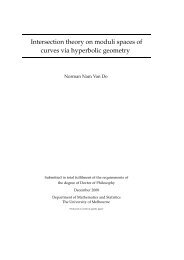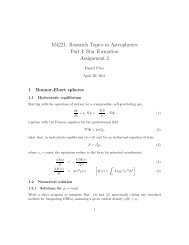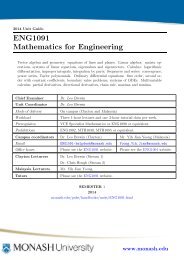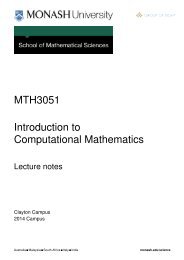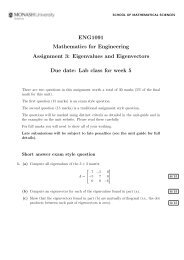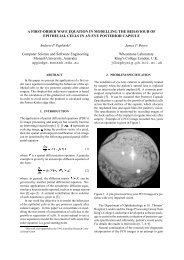Soft Matter - User Web Pages - Monash University
Soft Matter - User Web Pages - Monash University
Soft Matter - User Web Pages - Monash University
Create successful ePaper yourself
Turn your PDF publications into a flip-book with our unique Google optimized e-Paper software.
<strong>Soft</strong> <strong>Matter</strong><br />
View Article Online<br />
Paper<br />
Downloaded by <strong>Monash</strong> <strong>University</strong> on 13 March 2013<br />
Published on 22 February 2013 on http://pubs.rsc.org | doi:10.1039/C3SM00016H<br />
Fig. 7 Illustrations depicting the initial predominantly high (a) Wenzel wetting<br />
state of a drop on the surface in which with sufficient momentum developed (in<br />
the direction of the arrow) will (b) cause the drop to dislodge and leave behind a<br />
thin film of liquid. The very small volume of the latter renders it easily evaporable<br />
while the former now functions as a drop in the Cassie state.<br />
wetting state change here does not refute the notion that the<br />
Wenzel state is strongly irreversible. Wetting state changes are<br />
oen thought of as pertaining to the entire body of liquid. The<br />
ability of the liquid body to separate hence imbues the “liberated”<br />
component with the capacity to seek another predominant<br />
wetting state. Evidence of the ability of drops to separate<br />
on superhydrophobic surfaces has been reported, albeit in a<br />
different context. 32<br />
It is also apt at this point to mention that the conception of a<br />
fully Cassie state is not viable due to the heterogeneity of the<br />
microstructures developed (see Fig. 2). It has been previously<br />
established that the spacing between protruding microstructures<br />
and the height of the protruding microstructures dictate<br />
whether a droplet will assume Cassie or Wenzel states. 33 An<br />
interesting rumination relates to the interesting result of Jin<br />
et al. 34 that showed the possibility for superhydrophobic<br />
surfaces to possess strong adhesive forces by virtue of high van<br />
der Waals forces acting. Will it be possible to achieve the<br />
Wenzel to Cassie state changes with lowered movement of the<br />
drop during the shaking process This has advantageous<br />
implications in terms of practical device development.<br />
An ability to mathematically model the formation of a single<br />
drop from the spray of aerosol droplets will be instructive,<br />
although likely an involved undertaking due to the stochastic<br />
and dynamical nature of the mechanisms involved in (i) aerosols<br />
arriving at the receptacle surface, (ii) aerosols growing into<br />
drops, (iii) drops detaching from the surface under gravity, and<br />
(iv) drops coalescing. In the context of (iv), the unexpected<br />
drop–drop bouncing behavior recently uncovered on superhydrophobic<br />
surfaces 35 portends greater complexity in the<br />
modeling. We present here an elementary description of the<br />
extent of aerosol coverage on the surface that has implications<br />
for the mechanics of aerosols growing into drops.<br />
A single aerosol that arrives as a sphere with radius r 0 (which<br />
can be estimated to a high degree of accuracy using optical<br />
methods 36,37 ) on a semi-spherical surface of radius R will result<br />
in a liquid body that is governed by the equilibrium three-phase<br />
contact angle q. This can be described using a model<br />
comprising two spheres that intersect with each other. The<br />
parameters r 0 , R, and q can be related to the solid angle U via<br />
equations (outlined in the Appendix) that can be solved. The<br />
solid angle provides a convenient depiction of the extent of<br />
coverage taken from an assumed point source (the nebulizer).<br />
This is rather akin to the delivery of light from a point source in<br />
radiometry. 38<br />
Fig. 8 presents plots of U against r 0 /R for various values of q.<br />
As r 0 and R were 5 mm and 8.5 mm, respectively, the abscissa<br />
values were normalized to O(10 3 ). The values were found using<br />
Fig. 8 Plots of the solid angle U subtended by an aerosol droplet that arrives as a sphere with radius r 0 on a semi-spherical surface of radius R for various equilibrium<br />
three-phase contact angles q. The residence of the aerosol droplet on the surface can be described using a model comprising two spheres that intersect with each other.<br />
The relevant parameters can be related, via equations that can be solved, to the solid angle.<br />
3636 | <strong>Soft</strong> <strong>Matter</strong>, 2013, 9, 3631–3639 This journal is ª The Royal Society of Chemistry 2013


